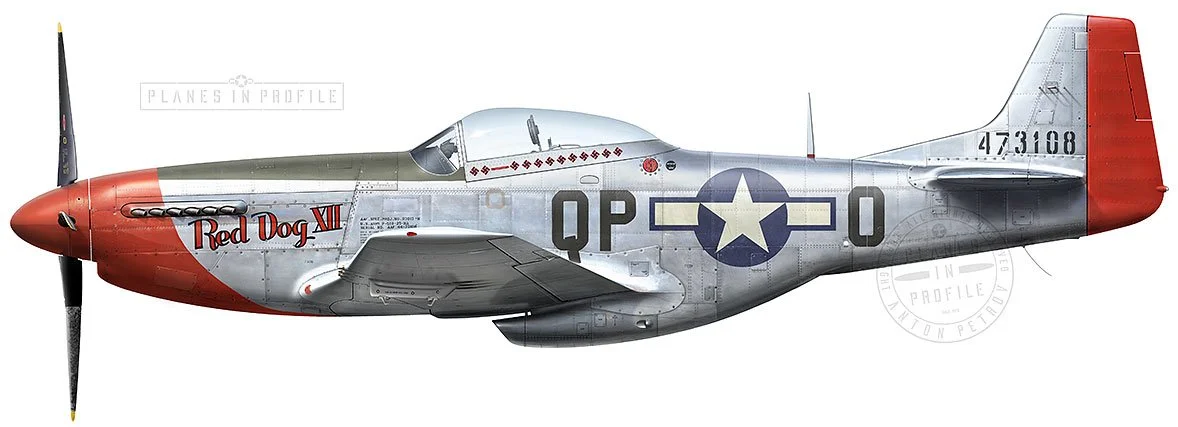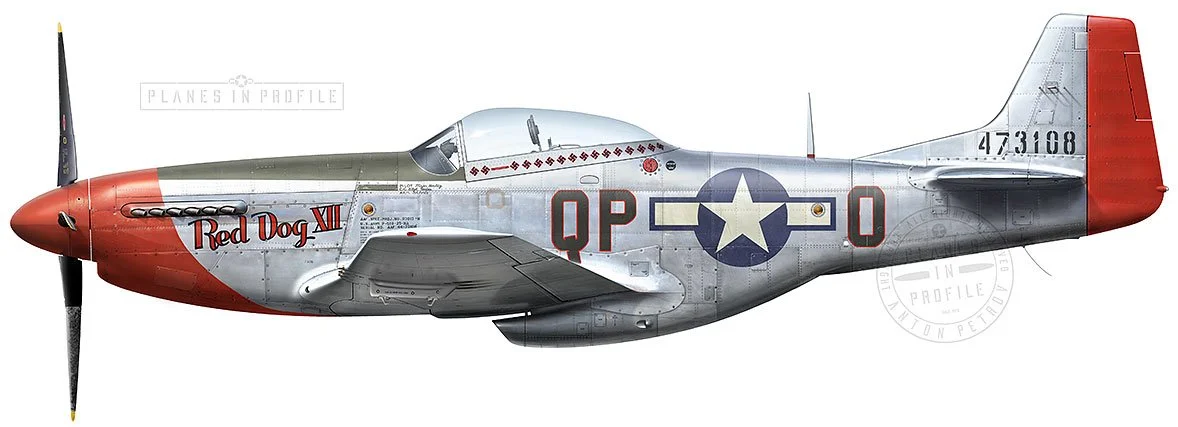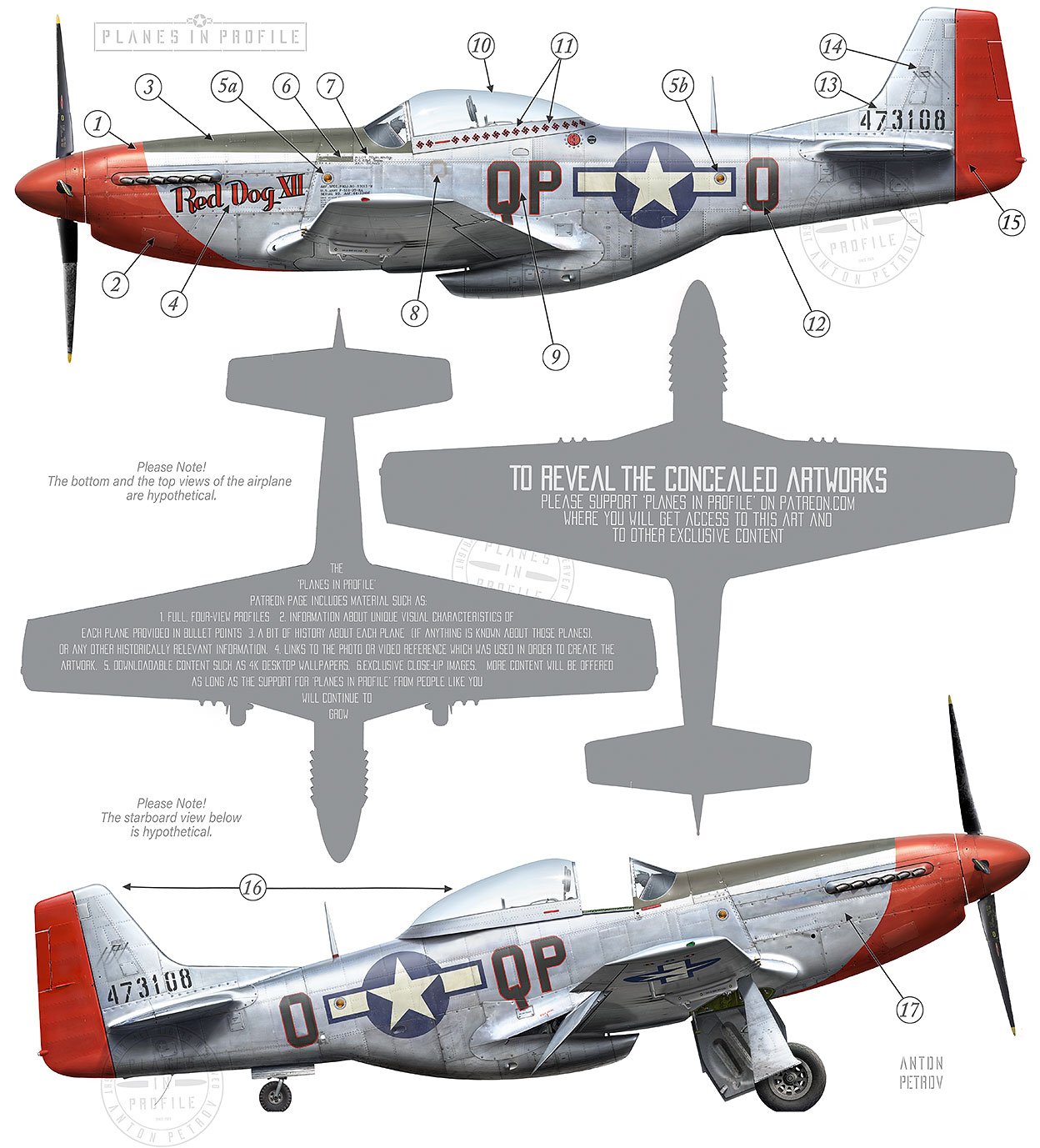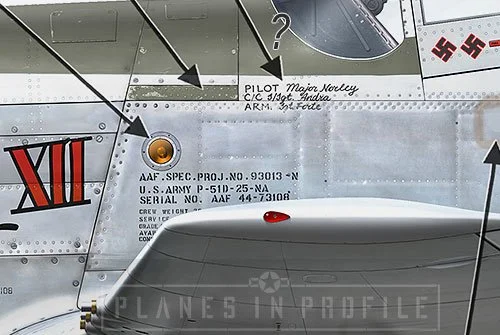Norley’s “Red Dog XII”
North American, P-51D-25-NA (Mustang), Serial number 44-73108
334th Fighter Squadron, 4th Fighter Group, 8th Air Force, Debden (Essex, England), circa April 1945.
Flown by (then) Maj. Louis Herman (Red Dog) Norley Jr. (An ace officially credited* with 10.333 aerial victories, 1 damaged, 5 ground victories)
The image above shows plane 44-73108 as it probably looked shortly before April 1945. The image is based on this photo.
Louis H. Norley Jr. joined the 4th FG on July 10th, 1943 and ended the war having served with all three of the group’s squadrons, even becoming the commanding officer of the 335th squadron in 1944 and then the CO of the 334th squadron from 25th of January past the war’s end through to 21st of September 1945. While commanding the 334th F.S. Maj. Norley was assigned three Mustangs, the last of which was plane number 44-73108 which became known as “Red Dog XII”. It was the last airplane assigned to him in WW2 and the only plane that Norley scored victories with in 1945.
The first victory Norley scored in this machine (but his 10.333d aerial victory overall) was in late afternoon of March 19th, 1945. It happened on a return trip from a fighter sweep deep into Germany. Leading the A Group, Maj. Norley spotted an Me-109 heading straight for Norley’s group near Frankfurt, so he did a sharp 180 and attacked the enemy. [1] Here is how Maj. Norley described it:
‘The Me-109 turned north and started a shallow dive. I closed to about 2000 yards, but before I could fire a shot he jettisoned his canopy. Feeling slightly cheated, I fired a couple of short bursts. The pilot of the Me-109 baled out and the fighter crashed and burned.’[2]
10.333) March 19, 1 x Me-109, 10miles SE of Frankfurt (Germany)
The second victory Norley scored in “Red Dog XII” (but his 11.333rd aerial victory overall) was somewhat controversial and therefore wasn’t officially credited to him. For this reason most sources state that Norley’s overall aerial victory count was 10.333 rather than 11.333. This last of Norley’s aerial victories happened just past noon on the 7th of April 1945 near Steinhunder Lake. While escorting B-24s tasked with striking the ammunition dumps at Duneburg and Krummel, Norley spotted two FW-190Ds heading for the American bomber formation. Maj. Norley climbed to chase one of them and when he got to about 600 yards of his target the Red Dog opened fire. At about that same time Norley also realised that the American bombers too were now in front of him, so he pulled off to the right. The FW-190D however didn’t change its trajectory and kept closing in on the Forts until it rammed into one of them, slicing off the Liberator’s tail. The collision caused both the enemy fighter and the American bomber to go down. It is interesting to note that the enemy was not firing as he closed on the bombers, which gave Norley a reason to believe that the ramming was not intentional. [1]
11.333) (Uncredited victory) April 7, 1 x FW-190D, Dannerberg area (Germany)
Just over a week later, on April 16th, 1945, as the 4th FG was likely attempting to compete for the title of the ‘highest scoring FG in the 8th Airforce’ before the war’s end, one of the group’s missions was to strike the remains of the Luftwaffe on the airfields around Karlsbad, Salzburg and Prague. Split into A Group and B Group, with Norley leading the B Group they unleashed fire as they dove down in repeated strafing runs. They caused impressive carnage that day, destroying 105 enemy aircraft on the ground. Red Dog XII was responsible for destroying 4 E/A that day as Norley strafed the enemy at the Gablingen aerodrome. He destroyed 2 x FW-190s, 1 x Ju-52 and 1 x unidentified twin-engined aircraft. [1] A few weeks later the war in Europe was over.
The image above shows what the plane probably looked like from late April, 1945 to the end of the war. The artwork is based on photo on this page.
Noteworthy Visual Characteristics
1) The sweped-back red nose colouring was the late-war identification marking of the airplanes of the 4th FG.
2) Note the carburettor air filter intake cover appears to be solid (unperforated). The solid covers were sometimes fitted onto the Mustangs in the European theatre because of the cold weather (or cold temperatures at high altitudes).
3) The anti-glare panel was painted with either Olive Drab or Black (non-glare) colour.
4) Red Dog XII was the name that appeared on Norley’s last airplane of the war. “Red Dog” was the nickname given to Norley because of his love of the game “Red Dog Poker”. Norley was assigned about 8 airplanes while in service with the 4th FG during the war. His first and fifth airplanes bore the name Red Dog, his 7th bore the name Red Dog XI and his 8th was the airplane featured on this page.
5) Note the presence of the ‘Formation lights’ or sometimes called ‘Slime lights’. These lights were meant to help pilots see each other’s airplanes when flying in formation.
These lights were evidently retrofitted onto Norley’s plane at some stage because we have a photo of Red Dog XII that doesn’t have these present.
6) Note a plate of a different colour. This patch of metal might have been coloured Olive Drab. It was possibly a piece of metal appropriated from an older, Olive coloured P-51.
7) These markings are the names of the pilot and crew. The top name was that of the pilot - Major Norley, the second was the name of the crew chief - Staff Sergeant Andra, and the third was the name of the Armourer which I was unable to confirm (I have tentatively written Sgt. Forte)
8) Note that the flare gun hole was covered up.
9) “QP” was the identification code of the 334th Fighter Squadron.
10) Note the late style '‘Dallas’ canopy with its distinctive kink at the back, designed to lessen the distortion in visibility.
11) 16 swastikas represent Norley’s 10.333 aerial + 5 ground victories, the last of which were scored on April 16th 1945. So the image portrays the airplane as it looked after that date.
12) “O” was the identification code of Norley’s plane. There is a very faint vertical line through the letter O, possibly the remaining effect of the stencil joint?
13) The number 473108 represents the plane’s serial production number 44-73108
14) Note the antenna array for the AN/APS-13 radar equipment.
15) The red rudder was the ‘late style’ colour identification of the 334th squadron.
16) There doesn’t appear to be an antenna wire on this airplane.
17) I have seen recreations of this airplane on the internet portraying an image of a cartoon dog on the starboard side of the nose, in the area indicated by the arrow. However, I have read that the image of the dog only appeared on Norley’s first Red Dog airplane, which was a P-47. Considering that it was quite uncommon to have nose art painted on the starboard side of the airplanes, I have decided to leave this area blank, since I believe this is more historically accurate.
Possible Evolution in external appearance
1) Note some tape over the gun camera, which seems to not be present on the plane later on.
2) Note the addition of the formation light on the nose (as well as over the bar of the insignia at the back of the plane)
3) Note the replaced rectangular metal plate.
4) Note the addition of the crew names
5) Note the 12 swastikas on the plane shortly before April, representing Norley’s 10.3 aerial and 1 ground victories. This was extended to 16 swastikas after April 16 when Maj.Norley scored his last victories.
6) It appears that there was no red outline around the letters QP and O originally. Later photos seem to have slightly thicker letters and a hint of an outline around the letter O, suggesting that there might have been a red outline applied around the letters.
FOOTNOTES
* Norley is usually credited with 11.333 aerial victories, but his last claim was listed as No Award in the VCB report. This information is according to the book “Stars & Bars” by Frank Olynyk.
[1] The descriptions of the victories are based on the book ‘P-51, Mustang Aces’, by William N. Hess and Thomas G. Ivie, published by Motorbooks International in 1992, page 96, ISBN: 0-87938-530-8
and
The book ‘4th Fighter Group, ‘Debden Eagles’’ by Chris Bucholtz, published by Osprey Publishing in 2008, pages 113, 116 and 117, PDF e-book ISBN:978 1 84603 809 9
[2] The book ‘4th Fighter Group, ‘Debden Eagles’’ by Chris Bucholtz, published by Osprey Publishing in 2008, pages 113, PDF e-book ISBN:978 1 84603 809 9
Other sources:
http://www.4thfightergroupassociation.org/uploads/8/2/0/3/8203817/336_norleylhweb_a.pdf
https://www.americanairmuseum.com/archive/person/louis-herman-norley
SUMMARY OF LINKS TO THE REFERENCE IMAGES AND/or VIDEOS
https://www.americanairmuseum.com/archive/media/media-21209jpeg
https://www.americanairmuseum.com/archive/media/media-14955jpeg
https://www.americanairmuseum.com/archive/media/media-21210jpeg
All the work presented on this page is subject to updates and revisions in the light of new information which might present itself. If you have any new information relevant to this page or disagree with anything that's presented here, then please contact me through the Planes in Profile Facebook page to help make the content of this page more accurate. Thanks:)






